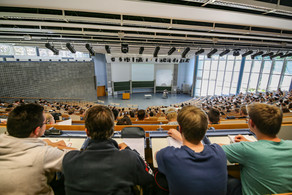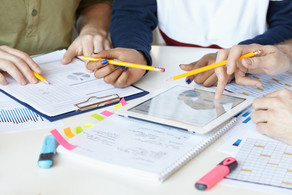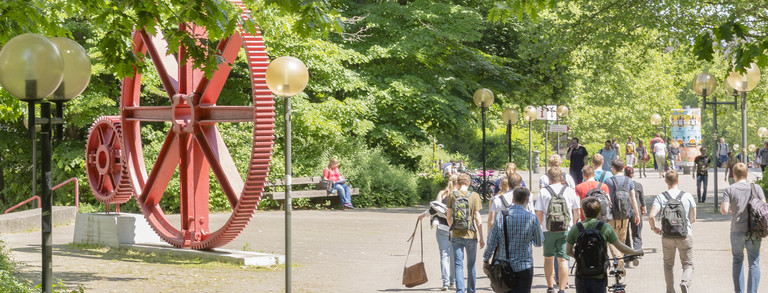Vision and visual impairment
The planned study will record how many primary school children in Germany wear glasses, as no figures are available to date. The prevalence of spectacle wear acts as an indirect measure of the refractive error rate. Since the refractive error rate is increasing worldwide, it is important to know how many children in Germany are refractive, because good vision is essential for healthy development. Possible causes for the increase are seen in the changed visual and living conditions: the increased use of electronic media, the intensive learning behavior and the reduced time spent outdoors. To investigate this, a questionnaire is being prepared to be completed by the parents of all first grade students in all 17 elementary schools in Witten. Accordingly, the goal is to conduct a full survey among the approximately 710 students. Witten is a possible representative town for the whole of Germany.
Project team: Helen Schneider, TU Dortmund; Prof. Dr. Sarah Weigelt, TU Dortmund
Project duration: since 01.06.2019
Link: BRIWI
For several years, the number of adults, children and adolescents with ametropia has been increasing worldwide. In Germany, too, the prevalence of ametropia has increased over the past decades. However, there is a lack of current figures on the prevalence of ametropia as well as on the prevalence and correction of refractive errors in general among children and adolescents in Germany. However, such current figures are important to assess the situation of eye health in children and adolescents and to possibly adapt prevention, diagnosis and treatment options.
To investigate this issue, we are conducting two different studies.
In the questionnaire survey, parents of children and adolescents of all ages fill out a short, anonymous online questionnaire about whether their children wear glasses and, if so, with which values - as can be read, for example, in the eyeglass passport. Anyone who lives in Germany and has one or more children up to and including the age of 17 can participate. It does not matter whether the children wear glasses or not. Vouchers worth a total of 500 euros will be raffled off among all participants.
In the school survey, we investigate the prevalence of ametropia among students in grades 3 and 4 as well as grades 8 and 9. For this purpose, we measure the objective refraction of the participants - i.e. the light refraction properties of the eye by which normal or defective vision can be recognized - quickly and without contact using a so-called autorefractometer.
The survey takes place at schools and the families of the participants receive information about our findings after their participation.
Project team: Astrid Hönekopp, TU Dortmund; Lisa-Marie Tommes, TU Dortmund; Prof. Dr. Sarah Weigelt, TU Dortmund
Link: MEPI
The function of visual skills is highly relevant in today's everyday life. They are also indispensable in school and especially in learning to read. A special type of visual acuity, vernier visual acuity, is associated with learning to read. The planned long-term study will investigate the extent to which learning to read is related to the development of visual acuity.
For this purpose, children in the last year of kindergarten (age 5-6 years, N = approx. 50-60) will be examined shortly before starting school, one year later and two years later. By examining the children several times, it is possible to map the developmental course of both reading skills and vernier visual acuity. Since the central research question of this project aims to relate visual acuity and reading skills, the children will undergo multiple tests of reading skills and visual acuity.
Testing of vernier visual acuity will be both behavioral and electrophysiological (EEG), as children at this age may not be able to adequately indicate how they perceive the stimuli presented. The non-invasive EEG offers a good opportunity here, since by measuring brain activity we do not have to rely on the participants' responses. A sample of young adults (age approx. 20-25 years, N = approx. 25) will serve as a comparison sample to the children.
Project team: Helen Schneider, TU Dortmund, Prof. Dr. Sarah Weigelt, TU Dortmund
Project duration: since 01.06.2019
Link: HYPER
Various subprojects are gathered under this project name, all of which investigate the neuronal development of visual perception in children using functional magnetic resonance imaging, i.e. looking, for example, at how the brain regions that process visual stimuli change over the course of development.
Funding: this project is supported by the Volkswagen Foundation.
Subprojects: The different subprojects can be found in the Department of Vision, Visual Impairment & Blindness.
Seeing is an ability that is highly relevant in everyday life. Very quickly and seemingly without effort, we perceive a wide variety of objects and their properties (such as shape, color, and size). The perceived size of objects plays an important role in navigation, for example, when we decide whether to pick up a small object or walk around a larger object. With our current study RealSize we want to find out how children perceive the world and how well they (know) or process the size of objects. For this purpose, we would like to investigate size processing in children without neurological or psychiatric pre-existing conditions at the age of 4 years and healthy young adults (age: approx. 18-30 years) as a control group using two established tasks on tablet computers.
Previous studies suggest that children as young as 4 years old can intuit the size of objects. We would like to replicate these results and also investigate the extent to which the 'true' size of objects plays a role in visual search. A study with adults shows that search performance is severely impaired as soon as an object appears unusually large. We investigate whether children are similarly affected by the expected size of objects when searching for them. For example, do children and adults perceive a huge lamp less quickly and reliably than a lamp of a familiar size?
Project team: Dr. Katharina Limbach, TU Dortmund University; Tim Johann, Jale Öztürk
Funding: this project is supported by the Volkswagen Foundation.
Link: RealSize
The Sehambulanz für Kinder (seki) [Outpatient clinic for children] is a diagnostic and research facility of the Department of Vision, Visual Impairment & Blindness of the Faculty of Rehabilitation Sciences and is under construction since the beginning of 2021.
seki is organizationally affiliated with the Center for Therapy and Counseling (ZBT).
We research vision in the context of learning disabilities.
We also address the spectrum of cerebral-related visual impairments in childhood.
With the support of a private foundation, we are thus exploring the relationship between vision and learning disabilities and the challenges of cerebral related visual impairments in our children's vision clinic.
For more information and news regarding diagnostic appointments and research projects, please see the seki website.
Investigations with a portable measuring instrument
For several years, the number of people with myopia has been increasing worldwide. In Germany, too, the prevalence of myopia has increased over the past decades. This development is mainly observed in younger age groups. There is much evidence to suggest that various environmental influences and behaviors in middle childhood and adolescence play an important role in this. Meanwhile, there are a few studies with portable measuring instruments that measure corresponding environmental influences directly in humans in field studies. However, no such study has yet taken place in Europe. Furthermore, the measuring instruments used so far are not ideally suited for collecting the desired environmental influences, especially in Western European climates.
For this reason, we are developing and testing a new measurement instrument that is as well adapted as possible to the conditions of the planned study. Subsequently, we will collect data in children and adolescents with and without myopia to generate information about the relationship between different environmental influences and myopia. Finally, these data should provide information about possible preventive approaches to prevent the development or intensification of myopia.
Project team: Astrid Hönekopp, TU Dortmund University; Prof. Dr. Sarah Weigelt, TU Dortmund University.
Link: ZUKU





